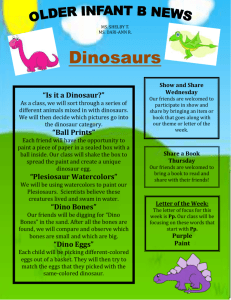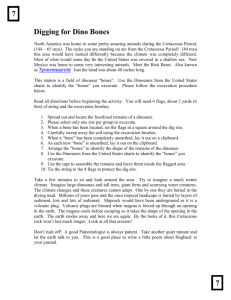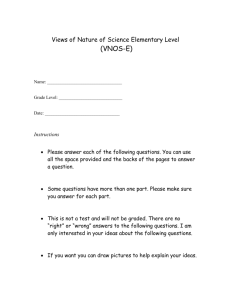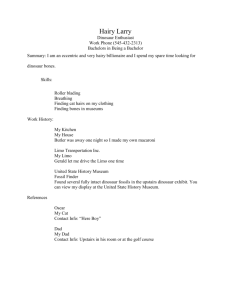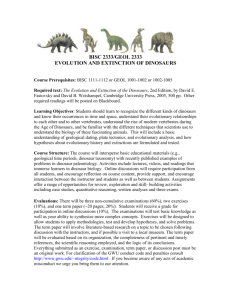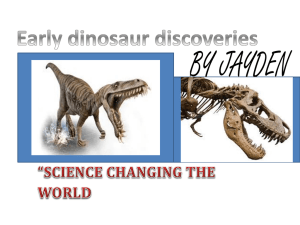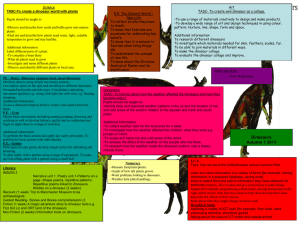Dragons and Dinosaurs
advertisement
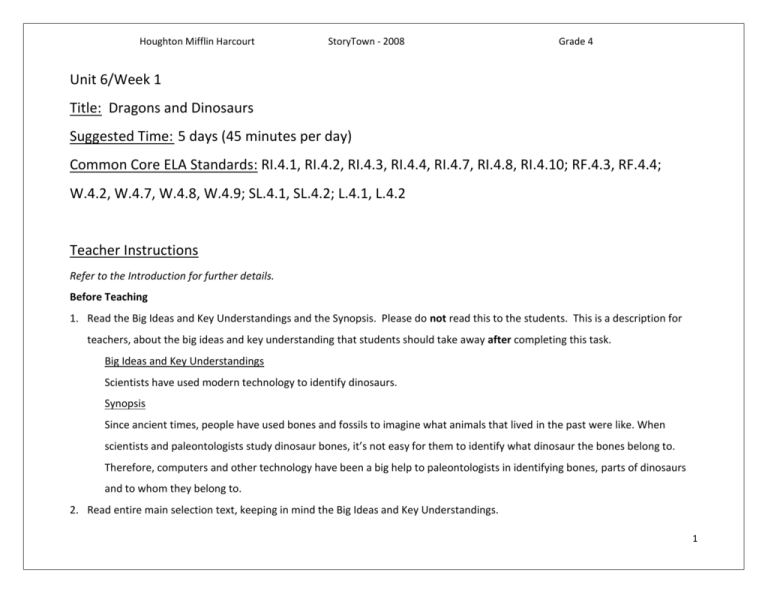
Houghton Mifflin Harcourt StoryTown - 2008 Grade 4 Unit 6/Week 1 Title: Dragons and Dinosaurs Suggested Time: 5 days (45 minutes per day) Common Core ELA Standards: RI.4.1, RI.4.2, RI.4.3, RI.4.4, RI.4.7, RI.4.8, RI.4.10; RF.4.3, RF.4.4; W.4.2, W.4.7, W.4.8, W.4.9; SL.4.1, SL.4.2; L.4.1, L.4.2 Teacher Instructions Refer to the Introduction for further details. Before Teaching 1. Read the Big Ideas and Key Understandings and the Synopsis. Please do not read this to the students. This is a description for teachers, about the big ideas and key understanding that students should take away after completing this task. Big Ideas and Key Understandings Scientists have used modern technology to identify dinosaurs. Synopsis Since ancient times, people have used bones and fossils to imagine what animals that lived in the past were like. When scientists and paleontologists study dinosaur bones, it’s not easy for them to identify what dinosaur the bones belong to. Therefore, computers and other technology have been a big help to paleontologists in identifying bones, parts of dinosaurs and to whom they belong to. 2. Read entire main selection text, keeping in mind the Big Ideas and Key Understandings. 1 Houghton Mifflin Harcourt StoryTown - 2008 Grade 4 3. Re-read the main selection text while noting the stopping points for the Text Dependent Questions and teaching Vocabulary. During Teaching 1. Students read the entire main selection text independently. 2. Teacher reads the main selection text aloud with students following along. (Depending on how complex the text is and the amount of support needed by students, the teacher may choose to reverse the order of steps 1 and 2.) 3. Students and teacher re-read the text while stopping to respond to and discuss the questions and returning to the text. A variety of methods can be used to structure the reading and discussion (i.e.: whole class discussion, think-pair-share, independent written response, group work, etc.) Text Dependent Questions Text Dependent Questions Culture means a particular group of people at a specific time and place. According to the text on page 674, many cultures describe the same imaginary creature differently, what do all the descriptions have in common? Cite specific evidence from the text that provides this description. In what ways was Protoceratops similar to the griffins that were imagined by ancient cultures? In what ways were they different? (Pgs. 674-675) What correct conclusion did ancient people draw about Evidence-based Answers According to the text on page 674, the author states, “Most ancient art shows them with gigantic beaks, claws, wings, and catlike bodies.” The Protoceratops and the griffin were similar after finding the birdlike skull of the Protoceratops; ancient cultures compared it to known creatures like the lion and eagle. They both had a huge beak and a frill on their monstrous heads. They were different because the Protoceratops was a real creature that became extinct, which scientists discovered using modern technology. Griffins were not real creatures but mythical beasts. The bones were from amazing creatures, quite different from 2 Houghton Mifflin Harcourt StoryTown - 2008 dinosaur bones? (Pg. 676) Using paragraphs 4-6 on page 676, explain why the author mentions the parts of a bicycle. Give specific evidence to show how this example of bicycle parts helps the reader better understand the process of finding dinosaur bones. List one misconception that Richard Owen had when naming dinosaurs. Why did he have this misconception? (Pg. 676) Using the bottom of pages 676-677, explain how scientists’ view of the Iguanodon changed with the use of technology. On page 678, what does the author mean when she says that paleontologists have a hard time “keeping up with all the bones”? What is the purpose of the author including this statement? What details make “The Case of the Deceptive Dinosaur” a good heading for the section starting on page 678? Use specific words or evidence from the text to support that help understand why this is an accurate heading for this section. Grade 4 the ones that appeared in real life. The author mentions the bicycle parts analogy to compare to the dinosaur bone analogy because scientists often have a difficult time trying to determine what a whole dinosaur may look like when they only find several bones at a time. This information helps give the reader an idea about the questions scientists must ask when they find fossils. For example, when scientists find fossils, they must figure out from the different parts what the dinosaur looked like. According to the text, scientists also have to determine how the bones fit together and which pieces are missing. Richard Owen didn’t realize that some dinosaurs were small and harmless, and they were very different from lizards. Originally, Gideon Mantel believed the Iguanodon was a huge creature that looked like a lizard with legs sprawling out to the side with a horn on its nose. Through the use of modern technology, scientists know that the Iguanodon had four straight legs similar to a mammal with the ability to walk upright. The author means that paleontologists cannot quickly study all the new dinosaur bones that are being found. Bones from more than one creature may be jumbled together, and scientists must work to separate each animal. The purpose of the author including this statement is to help readers understand the difficulties paleontologist face when identifying dinosaurs. This section tells how scientists were deceived into thinking that some bones from an Apatosaurus were from a different type of dinosaur. Because of this confusion, the Apatosaurus was pictured without a head for nearly one hundred years until the skull was found in a museum basement. Scientists have also discovered that the Apatosaurus as well as other dinosaurs 3 Houghton Mifflin Harcourt StoryTown - 2008 Using pages 680-681, give specific examples of how scientists have learned about the Apatosaurus from computer modeling. What can be concluded about the Apatosaurus from the computer modeling? Utilizing the picture on page 682, explain how this picture relates to the heading, “Listening to the Bones”. How did computer modeling help scientists determine where long necks probably lived? Provide evidence from the text that supports your response. (Pg. 683) Explain how special imaging equipment helped scientists better understand the crest of the Parasaurolophus and the brain of the Tyrannosaurus. (Pg. 684) Grade 4 with long necks may not have been able to lift their heads far off the ground to eat leaves from trees as scientists once thought. In fact, the name Apatosaurus means “deceptive lizard.” Scientists have learned that through the use of computer modeling, the Apatosaurus could not raise its neck very high, so it probably ate food along the ground rather than the treetops. Also, computer modeling has revealed that the Apatosaurus could have cracked its tail like a whip creating a supersonic boom. However, scientists think this is unlikely because supersonic tail wagging would have damaged the dinosaur’s tail. The picture on page 682 shows scientists with their ears pressed against a large dinosaur bone. Today scientists don’t actually listen to the bones with their ears, but with computers they can hear what dinosaurs may have sounded like. The computer modeling showed that long necks had tiny air sacs along their spines. These tiny air sacs would help them stay afloat. Their long necks helped them keep their heads above water to breathe as they walked along the bottoms of lakes and rivers grazing on soft aquatic plants. This led scientists to conclude that the long necks probably lived in the water. By taking CT scans of the fossils, scientists were able to view the inside of the Parasaurolophus’ crest and Tyrannosaurus’ skull without destroying the fossil. They were able to create 3dimensional image of the crest with its complicated tubes and chambers and hear the eerie sounds that the Parasaurolophus may have rumbled. The scans also showed information about the size and function of the Tyrannosaurus’ brain including its ability to smell. 4 Houghton Mifflin Harcourt StoryTown - 2008 Grade 4 Vocabulary STUDENTS FIGURE OUT THE MEANING sufficient context clues are provided in the text TEACHER PROVIDES DEFINITION not enough contextual clues provided in the text KEY WORDS ESSENTIAL TO UNDERSTANDING Page 674- fossil Page 674-ancestors Page 675- species Page 676- ferocious Page 681- supersonic (breaking the sound barrier) Page 683- grazing Page 674- ancient Page 676- extinct WORDS WORTH KNOWING General teaching suggestions are provided in the Introduction Page 676- contraption Page 678- deceptive Page 680- obstacles Page 684- complicated Page 674- culture Page 677- sprawled Page 680- vegetarian Page 683- massive Page 683- submerged Page 683- aquatic Page 684- eerie 5 Houghton Mifflin Harcourt StoryTown - 2008 Grade 4 Culminating Task Re-Read, Think, Discuss, Write After rereading Dragons and Dinosaurs, write a well-developed paragraph explaining how the descriptions of dinosaurs have changed from ancient cultures to the descriptions of today through the use of modern technology. Use specific details and information from the text to support and justify your answer. When writing your paragraph, be sure to indent, use correct spelling, punctuation, capitalization, and proper sentence formation. Answer: Unlike people from ancient cultures, scientists of today use modern technology to learn more about dinosaurs. In ancient times, people explained the mysterious bones they found by creating legends of mythical creatures with gigantic beaks, claws, wings, and catlike bodies. Today, paleontologist use computer technology in many ways to discover more scientific information about the ancient and extinct dinosaurs. For example, in the case of the Iguanodon, scientists used computers and 3-dimensional scans to learn more accurate information about the appearance of the dinosaur over time. Special imaging equipment, like x-rays and CT scans, has allowed scientists to judge the size of the brain of certain dinosaur species. Through the use of this technology, computers have helped paleontologists see dinosaur images by allowing them to see inside three-dimensional models of dinosaur bones. As new technology advances more information will be gained from dinosaur fossils in the future. 6 Houghton Mifflin Harcourt StoryTown - 2008 Grade 4 Additional Tasks Research a specific dinosaur. Use available resources to find facts and information. Write a two-paragraph description of the dinosaur using the facts and information collected. Be sure to provide a list of reference sources that were utilized for the research. Read the online version of Charlie McDuff and the Test of Time by I. MacPenn, which is located at www.enchantedlearning.com. Compare and contrast the descriptions of the dinosaurs within the text with facts learned from the selection, Dragons and Dinosaurs. Remind students that as they read they can use graphic organizers to keep track of relationships between events. Have the students draw a sequence graphic organizer to record how scientists’ ideas about long necked dinosaurs have changed over the years. Note to Teacher Some vocabulary words like paleontologist, griffins, and CT scans are domain-specific, Tier 3 words. However, these words need to be brought to the students’ attention because they are essential to the understanding of the big idea. The students may identify these words with fast mapping and grapple with them while reading the text. Pair this selection with a brief video clip about dinosaurs explaining about their being extinct. Show and discuss video after completing story. According to HMH, the lexile level of this text is 1020L, so students may need the teacher to read aloud the scientific terms at least a few times. Be prepared to model and choral read challenging parts in the text. To meet the RF.4.3a standard, model using phonetic skills to pronounce dinosaur names and scientific terms found in the passage. 7 Houghton Mifflin Harcourt StoryTown - 2008 Grade 4 8 Houghton Mifflin Harcourt StoryTown - 2008 Grade 4 Name _______________________________________________ Date _________________ “Dragons and Dinosaurs” 1. Culture means a particular group of people at a specific time and place. According to the text on page 674, many cultures describe the same imaginary creature differently, what do all the descriptions have in common? Cite specific evidence from the text that provides this description. 2. In what ways was Protoceratops similar to the griffins that were imagined by ancient cultures? In what ways were they different? (Pgs. 674-675) 3. What correct conclusion did ancient people draw about dinosaur bones? (Pg. 676) 4. Using paragraphs 4-6 on page 676, explain why the author mentions the parts of a bicycle. Give specific evidence to show how this example of bicycle parts helps the reader better understand the process of finding dinosaur bones. 9 Houghton Mifflin Harcourt StoryTown - 2008 Grade 4 5. List one misconception that Richard Owen had when naming dinosaurs. Why did he have this misconception? (Pg. 676) 6. Using the bottom of pages 676-677, explain how scientists’ view of the Iguanodon changed with the use of technology. 7. On page 678, what does the author mean when she says that paleontologists have a hard time “keeping up with all the bones”? What is the purpose of the author including this statement? 8. What details make “The Case of the Deceptive Dinosaur” a good heading for the section starting on page 678? Use specific words or evidence from the text to support that help understand why this is an accurate heading for this section. 10 Houghton Mifflin Harcourt StoryTown - 2008 Grade 4 9. Using pages 680-681, give specific examples of how scientists have learned about the Apatosaurus from computer modeling. What can be concluded about the Apatosaurus from the computer modeling? 10. Utilizing the picture on page 682, explain how this picture relates to the heading, “Listening to the Bones”. 11. How did computer modeling help scientists determine where long necks probably lived? Provide evidence from the text that supports your response. (Pg. 683) 12. Explain how special imaging equipment helped scientists better understand the crest of the Parasaurolophus and the brain of the Tyrannosaurus. (Pg. 684) 11
